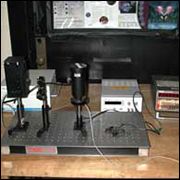Description

Photoelectric effect experiment equipment. (Image courtesy of MIT Junior Lab staff.)
The maximum kinetic energy of electrons ejected from a metal surface by monochromatic light is measured for several wavelengths. The value of Planck's constant, h, is derived by an analysis of the data in the light of Einstein theory of the photoelectric effect.
Lab Guide
Photoelectric Effect Lab Guide (PDF)
References
Planck, Max. Nobel Prize Lecture, "The Genesis and Present State of Development of the Quantum Theory." (1918).
Einstein, Albert. Nobel Prize Lecture, "Fundamental Ideas and Problems of the Theory of Relativity." (1921).
Millikan, R.A. "A Direct Photoelectric Determination of Planck's 'h'." Phys. Rev., 7, 355 (1916).
 Hughes, Arthur L., and Lee A. Du Bridge. Photoelectric Phenomena. Boston, MA: McGraw-Hill, (1932).
Hughes, Arthur L., and Lee A. Du Bridge. Photoelectric Phenomena. Boston, MA: McGraw-Hill, (1932).
Discusses phenomena such as the velocity distribution of the electrons, effects of polarization and angle of incidence of the light, influence of the surface temperature, photoelectric behavior of thin films and composite materials, etc.
 Harnwell, G. P., and Livingood, J. J. "Thermionic and Photoelectric Effects." In Experimental Atomic Physics. Boston, MA: McGraw-Hill, 1933, pp. 214-223. ISBN: 9780070266605.
Harnwell, G. P., and Livingood, J. J. "Thermionic and Photoelectric Effects." In Experimental Atomic Physics. Boston, MA: McGraw-Hill, 1933, pp. 214-223. ISBN: 9780070266605.
 Melissinos, Adrian C. "Photoelectric Effect." In Experiments in Modern Physics. New York, NY: Academic Press, (1968).
Melissinos, Adrian C. "Photoelectric Effect." In Experiments in Modern Physics. New York, NY: Academic Press, (1968).
Selected Resources
Baumeister, P. and G. Pincus. "Optical Interference Coatings." Scientific American 223, 58-75 (December 1970).
